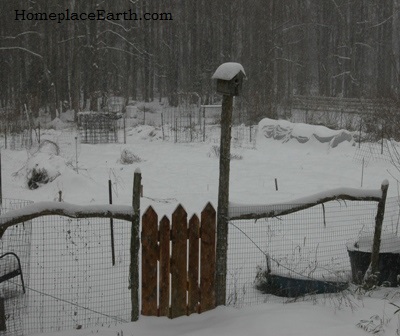
We were recipients of some of the snow that fell on the east coast over the weekend. It was 14” deep at our house. It isn’t the most snow that I remember having here, but it is the most since January 1996 when we had 20”. We still had our milk cow then and I remember shoveling a path to the barn when the snow was at 10”, knowing I would be shoveling again. The path had to be a wide one—wide enough for me to walk with two five-gallon buckets of water.

snow covered low tunnel
This time around I have kept busy finalizing my presentation for the upcoming Virginia Biological Farming Conference, shoveling snow, and knitting a sweater. Snow like this disturbs everyone’s schedule, for sure. But, as bothersome as that is, it presents a lot of opportunities. Of course, if you have been following my blog, you would know that I look at everything as an opportunity. It is when our structures are tested and we find out how well we’ve done. If you planned your low tunnels, coldframes, and greenhouses to withstand your usual conditions, you might find them collapsed in the snow. This snow reveals if they were built beyond the usual conditions.
It is good to know. This is the sort of thing you have to plan for from the beginning. Yes, it doesn’t happen very often and may not occur again for another twenty years, but the way the weather has been in recent years, I would build with the assumption that it could happen every year. That will put you at ease whenever severe weather strikes again.
As the kids were growing up, whenever we had a big snow that shut things down my husband would take them for late night walks down the road for at least a half-mile or more. Well, the kids are grown and establishing their own snow traditions and now it is me accompanying my husband on those moonlight walks. We went out on Friday and Saturday nights under the full moon and it was wonderful. Since the power hadn’t gone out, which was surprising, noisy generators didn’t disturb the silent night.
The first night it was still snowing when we went out and there was quite a bit of wind. We were walking in the road on snow. The plows had been out, but that didn’t mean the roads were fit to drive on. The next night I could feel the difference in the surface beneath my boots. Although not much traffic had been on them, the surface had turned to ice and there were lots of drifts across the road. So much so that the drifting snow and icy road had caused a snow plow to get stuck. He was waiting for a tow when we came upon him about midnight.

paths to the chicken house and barn
That walk brought to mind how important it is to get out and walk the ground to really know how it is; although, I’m usually referring to walking in gardens, possibly in your bare feet, when I talk about that. Looking out my window, either from my house or a vehicle, couldn’t have told me the road conditions like walking on the ice and through the drifts.
The roads in our area are full of curves and wooded areas. Even when the roads are clear after a snow, we know to look out for the areas where there are trees on the south side. Their shade keeps ice on the road in spots long after it has melted elsewhere. We can learn about where the cooler areas due to shading are in our gardens by watching the snow melt. I wrote a blog post about that in February 2014.
I hope you have enjoyed the winter weather at your place. It reminds us not to take ourselves too seriously. Things we have planned to do get changed, and that’s okay. It is an opportunity to slow down and check on our neighbors. Sitting by the woodstove is great, also. And about that snow shoveling—welcome it as a needed winter workout and be thankful that you are healthy enough to do it.
 Here it is– a new year and time to plan your new garden. Before you do that, however, I urge you to think about last year’s garden. Most likely, if you are reading this you probably did some sort of planning last year. That’s what my DVD
Here it is– a new year and time to plan your new garden. Before you do that, however, I urge you to think about last year’s garden. Most likely, if you are reading this you probably did some sort of planning last year. That’s what my DVD  For many years my garden plan consisted mainly of my garden maps, the one I made showing what I intended to plant where and when, the Actual version that showed what actually happened, and the Amendments version that showed what amendments were added to each bed and when. It is the Actual version that will help you plan this year’s garden. If you completed it you will know what was in each bed throughout the year and when it was planted, particularly, what is in there now; but the subject of
For many years my garden plan consisted mainly of my garden maps, the one I made showing what I intended to plant where and when, the Actual version that showed what actually happened, and the Amendments version that showed what amendments were added to each bed and when. It is the Actual version that will help you plan this year’s garden. If you completed it you will know what was in each bed throughout the year and when it was planted, particularly, what is in there now; but the subject of 





